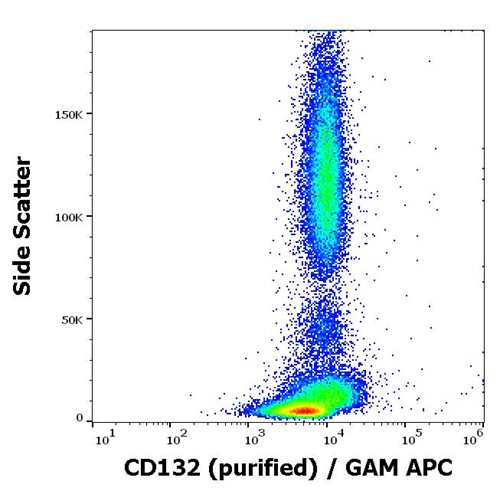Human TNFRSF11A Recombinant Protein (Fc Tag)(Discontinued)
Shipping Info:
For estimated delivery dates, please contact us at [email protected]
| Amount : | 100 µg |
| Purification : | > 90 % as determined by SDS-PAGE |
| Content : | Formulation Lyophilized from sterile PBS, pH 7.4. Normally 5 % - 8 % trehalose, mannitol and 0.01% Tween80 are added as protectants before lyophilization. |
| Storage condition : | Store it under sterile conditions at -20°C to -80°C. It is recommended that the protein be aliquoted for optimal storage. Avoid repeated freeze-thaw cycles. |
| AA sequence : | Met1-Pro212 |
| Alternative Name : | CD265 Protein, FEO Protein, LOH18CR1 Protein, ODFR Protein, OFE Protein, OPTB7 Protein, OSTS Protein, PDB2 Protein, RANK Protein, TNFRSF11A Protein, TRANCER Protein, |
Source : HEK293 Cells
TNFRSF11A is a member of the TNF-receptor superfamily. In mouse, it is also known as CD265. TNFRSF11A contains 4 TNFR-Cys repeats and is widely expressed with high levels in skeletal muscle, thymus, liver, colon, small intestine and adrenal gland. It is an essential mediator for osteoclast and lymph node development. TNFRSF11A and its ligand are important regulators of the interaction between T cells and dendritic cells. It can interact with various TRAF family proteins, through which this receptor induces the activation of NF-kappa B and MAPK8/JNK. Defects in TNFRSF11A can cause familial expansile osteolysis (FEO). FEO is a rare autosomal dominant bone disorder characterized by focal areas of increased bone remodeling. Defects in TNFRSF11A also can cause Paget disease of bone type 2 (PDB2). PDB2 is a bone-remodeling disorder with clinical similarities to FEO. Defects in TNFRSF11A are the cause of osteopetrosis autosomal recessive type 7 which characterized by abnormally dense bone, due to defective resorption of immature bone.
TNFRSF11A is a member of the TNF-receptor superfamily. In mouse, it is also known as CD265. TNFRSF11A contains 4 TNFR-Cys repeats and is widely expressed with high levels in skeletal muscle, thymus, liver, colon, small intestine and adrenal gland. It is an essential mediator for osteoclast and lymph node development. TNFRSF11A and its ligand are important regulators of the interaction between T cells and dendritic cells. It can interact with various TRAF family proteins, through which this receptor induces the activation of NF-kappa B and MAPK8/JNK. Defects in TNFRSF11A can cause familial expansile osteolysis (FEO). FEO is a rare autosomal dominant bone disorder characterized by focal areas of increased bone remodeling. Defects in TNFRSF11A also can cause Paget disease of bone type 2 (PDB2). PDB2 is a bone-remodeling disorder with clinical similarities to FEO. Defects in TNFRSF11A are the cause of osteopetrosis autosomal recessive type 7 which characterized by abnormally dense bone, due to defective resorption of immature bone.
Measured by its ability to inhibit TRANCE-induced osteoclast differentiation of RAW 264.7 mouse monocyte/macrophage cells. The ED50 for this effect is 3-16ng/mL in the presence of 5 ng/mL of TRANCE.
Endotoxin :< 1.0 EU per µg of the protein as determined by the LAL method
For Research Use Only. Not for use in diagnostic/therapeutics procedures.
|
There are currently no product reviews
|


























.png)










